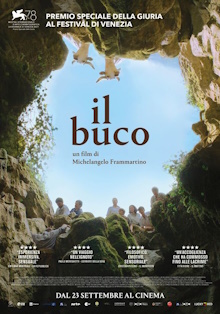This may an Italian film but it barely matters as there is no dialogue whatsoever. There’s only a foreword and an afterword in Italian explaining what it’s about. Instead what we have is pure visual storytelling and some of the best cinematography I’ve seen in recent years. This is also a film that defies genres. It’s technically a dramatic reenactment of an event in 1961, the exploration of the Bifurto Abyss cave system. Yet it’s staged like a documentary with no particular focus on any characters with the exception of a local of the area. It is amazing in all respects and it makes me wonder what other historical films might be like if they were made like this.
An elderly man perches over a magnificent view of mountains and pastures as he watches over a herd of cows. Occasionally he calls out to his animals and the sound rolls across the landscape. This is the deeply rural Calabrian region, far to the south of Italy in 1961. A truck carrying a team of young scientists along with their equipment and supplies arrive at the nearest village. It’s easily the most exciting thing to happen there for a while and the children gleefully play with the new arrivals. The next day the truck takes them to their real destination: the Bifurto Abyss. It is a cave that is literally a hole in the ground, cutting straight down through the pasture. Over the following days and weeks, the film documents the team exploring the cave system cavern by cavern. They lower members down on ropes, then later construct a rope ladder and a pulley system. In this era before modern tools and electronics, they rely on oil-lit headlamps for illumination and return to the surface to sleep in tents. They take measurements by hand and the cartographer transcribes everything onto paper. The elderly herder impassively watches everything from his perch.
All this is conveyed with no intelligible dialogue. The young speleologists grunt and yell at one another but there are no subtitles and we’re meant to hear exactly what is being said. It’s fine though as we can understand well enough what they mean from their body language and the context. The camera work is exquisite, whether it is capturing the beauty of the landscape or the flickering shadows of the underground. Every frame fully captures your attention and so many shots will leave you wondering how director Michaelangelo Frammartino achieved it. We know that it must all be fictional as it’s a reenactment but everything feels so authentic and we can’t help but be convinced that it is a documentary. I’d imagine that the scenes of life in the village, as they gather to communally watch a television, as the scientists bed down in the local church, as the local children are teased by the visitors, must be much as it really was in the 1960s.
The most enigmatic part of the film is the character of the elderly herder, the sole person that is distinguishable from the background. The director’s purpose in highlighting him is open to interpretation. One possibility is just to depict the traditional way of life of the locals of the area. A more fanciful interpretation might be to relate his falling sick to the explorers plumbing the depths of the cave, as if in revealing the secrets of the Bifurto Abyss to the world, some of the vitality of the land has been lost. Whatever the reason, this inclusion undeniably adds a sense of wonder to this reenactment of a scientific survey. The combination is magical, turning this into a true work of art. From what I understand, Frammartino’s other films work similarly but he is as yet not a very well known director so it will not be easy to get a hold on them.
Even though the Bifurto Abyss was discovered to be the third longest cave system in the world at the time, I doubt that this expedition was ever that significant. It seems likely that Frammartino knew about it because of his own Calabrian heritage. To my mind, this counts as another one of those films that are extremely local in scope but shows such deep affection and familiarity with the place that it is superlative in quality.
